Dynafit DNA Boot Overview
Consistent with some of my other outside the box ski gear ideas, my first day skiing the Dynafit DNA was a ~15” powder day, paired with 120mm Moonlight Cruiser skis. I had a blast.
A bold pairing – 186cm Moonlight Cruiser (120mm underfoot) with the DNA boot. Perhaps a bold pairing – 186cm Moonlight Cruiser (120mm underfoot) with the DNA boot.
New in 2022, the Dynafit DNA is something between a replacement for the now discontinued PDG 2 and a bridge to the pricey DNA by Pierre Gignoux model. For me, as a non-racer, the PDG never seemed like a viable option for driving slightly bigger skis, and the Gignoux boots, while extremely sexy, always felt like a bit much, both in price and carbon content. Come fall 2022, as I mourned the demise of my beloved set of Scarpa Alien RS, seeing the new DNA boot gave me a sliver of hope.
My hopes were tempered by a bit of concern about fit–Dynafit boots have been all over the map for a little while now, from cavernous models like the TLT7 or Hoji Pro, to low volume options like the Hoji Free, I wasn’t sure what to expect. More on fit later, but the DNA is pretty darn low volume.
Over the past few seasons, it seems that Dynafit has upped their boot game significantly, from these new DNA and the similar Mezzalama model, to the TLTX, Radical Pro, and Tigard. Dynafit have competitive boots (with toe welts) from 800g race boots to 1600g 50/50 boots.
Design Highlights
The DNA is categorized as a pure skimo race boot, and would likely perform admirably in such a role. For better or worse, I don’t find it particularly interesting, assessing how a boot performs survival skiing as fast as possible on 65mm skis in bad snow (although that can be very exciting in the moment!). My vision for the DNA was to class things up a little and see if it could compete in the ever busier 1 kg category. Though I have really enjoyed other 1 kg boots, especially the Technica Zero G Peak, lately, I often missed the slick, single throw transition of my beloved Alien RS. Also, the Technica is light and skis well, but the walking isn’t as friction-free as I would like some days.
%91caption id=%22attachment_7546%22 align=%22aligncenter%22 width=%221080%22%93 Dynafit DNA, fresh out of the box%91/caption%93
Dynafit DNA, fresh out of the box%91/caption%93
The DNA has some race features that set it apart from most of the 1 kg boots out there. A full carbon cuff is perhaps the biggest difference. With a full carbon cuff and carbon loaded Grilamid lower, this puts the DNA in the category of the Scarpa Alien 1.1 and La Sportiva Raceborg II. Often, these boots (especially the Scarpa) are characterized as extremely stiff and harsh, and just generally challenging to ski. Trying on the DNA and Alien 1.1 side by side, the DNA has a notably softer and less harsh feeling – more similar to the Alien RS than the 1.1.
Speaking of the Alien RS, the basic design of the DNA is very similar. It shares a BOA style lower clog closure – although the implementation is a bit different. Dynafit uses a Twistfit branded system, and the cables tighten down a plastic plate over the instep. The upper closure also more or less resembles the Alien RS (and other race boots) with a single throw to lock the upper cuff into ski mode and tighten a Dyneema cord across the shin. The Dynafit cord system is somewhat refined as well, relative to the Alien RS. It uses a plastic sleeve that latches to a metal stud of sorts, which makes the on/off process a bit easier. Adjusting the cord tension felt a bit more cumbersome than the Scarpa system with the cam–although I know some folks had issues with slipping or de-sheathing the cord, I found it simple to set my desired tightness, then tie a slip knot behind the cam to lock things in place. The Dynafit system, I’m not quite sure I have figured out yet.
%91caption id=%22attachment_7529%22 align=%22aligncenter%22 width=%221024%22%93 A good view of the walk/ski mechanism and the cord adjustment system that I’m still not quite sure I understand.%91/caption%93
A good view of the walk/ski mechanism and the cord adjustment system that I’m still not quite sure I understand.%91/caption%93
The bayonet style walk/ski mode lever is free floating (no spring loading), and closes onto a round stud. This mechanism feels robust and simple, relative to the svelte nature of the boot. The soles are Pomoca rubber, and non-norm certified–tech bindings only. The open instep of the lower clog is covered by a zippered gaiter that I wish went a little higher for my powder skiing exploits. While there were early reports of zipper failure on these boots and their cousin the Mezzalama, I mitigated this by only operating the zipper with the Twistfit tightened, to limit the stress on the zip. The forward lean is adjustable between 10 and 13 degrees by flipping the stud on the lower shell.
%91caption id=%22attachment_7524%22 align=%22aligncenter%22 width=%221024%22%93 Pomoca outsole, tech bindnigs only.%91/caption%93%91caption id=%22attachment_7523%22 align=%22aligncenter%22 width=%221024%22%93
Pomoca outsole, tech bindnigs only.%91/caption%93%91caption id=%22attachment_7523%22 align=%22aligncenter%22 width=%221024%22%93 The low cut gaiter leaves a gap for snow ingress in powder.%91/caption%93%91caption id=%22attachment_7538%22 align=%22aligncenter%22 width=%221024%22%93
The low cut gaiter leaves a gap for snow ingress in powder.%91/caption%93%91caption id=%22attachment_7538%22 align=%22aligncenter%22 width=%221024%22%93 The %22stud%22 lower shell connection. Flipping this stud changes from 10 degrees to 13 degrees.%91/caption%93
The %22stud%22 lower shell connection. Flipping this stud changes from 10 degrees to 13 degrees.%91/caption%93
Perhaps the elephant in the room for non-racers is the bikini style liner. My first encounter with a liner like this wasn’t all bad, I used the bikini liners for some on piste tours, as well as a few backcountry laps. Certainly, the flimsy and backless liner is a serious compromise to downhill performance, but holy cow do they walk well, we are talking near zero friction over a much wider ROM than my ankle is capable of. I ended up swapping the liners, more on this later.
Fit and Bootfitting
I am the proud owner of feet that are large (EU 46 or so), but also narrow and low volume in most of the ways. I have a medium-low instep, medium arch, and fairly bulbous sixth toes. I often need sixth toe punches and occasionally padding or shimming in the heel cup of new boots to mitigate heel lift. I opted for the size 29.5/30 shell, which, at 311 mm is a touch shorter than my size 30 Alien RS that was 318 mm. Internal length was also a touch shorter on the DNA, but I would likely recommend the same sizing as Scarpa. I wear a 28.5 in Technica Zero G/Peak and others, for reference.
The most notable fit-feature of the DNA is the very low volume forefoot, the toe box and midfoot height is the lowest of any boot I have worn, but the width is decidedly medium (no sixth toe punches needed for me). I struggled a bit with heel hold, as the heel area is a bit higher volume than the rest of the boot. I often felt that the Twistfit tightening in the forefoot could have gone a hair higher toward my ankle to assist with heel hold, or I have contemplated some sort of a modification for an instep buckle to alleviate this issue – perhaps I’ll explore this in the future. For the time being, a liner swap and some padding is doing an adequate job.
%91caption id=%22attachment_7539%22 align=%22aligncenter%22 width=%221024%22%93 Stock liner – race ready, but perhaps not ideal for day to day touring.%91/caption%93
Stock liner – race ready, but perhaps not ideal for day to day touring.%91/caption%93
As far as boot work goes, the stock liner took some shape from heat molding, but there isn’t much material to work with. The carbon cuff is not readily modifiable, but the lower should take small amounts of punching. There are some reinforced areas molded into the lower shell (similar to the Lambda Frame on the Alien RS) that would likely be challenging to work around for some punches in the midfoot area.
%91caption id=%22attachment_7534%22 align=%22aligncenter%22 width=%221024%22%93 External plastic reinforcement similar to the Alien RS Lambda Frame%91/caption%93
External plastic reinforcement similar to the Alien RS Lambda Frame%91/caption%93
Field Testing
I skied a bit with the stock liner, but mostly tested with an Intuition Tour Mod, which is essentially an Intuition foam, super simple and thin race liner. I also tried the stock Zero G Peak Liner for a few days–mostly to see if I liked the full liner before purchasing the Intuition. I added a super thin Kneed 2 Fit insole to each of the liners as well.
%91caption id=%22attachment_7530%22 align=%22aligncenter%22 width=%221024%22%93 Dynafit DNA boot + Intuition Tour Mod Liners = Capable ski touring boots.%91/caption%93
Dynafit DNA boot + Intuition Tour Mod Liners = Capable ski touring boots.%91/caption%93
The walk mode, like I mentioned, was exceptional. With the bikini liner it was truly frictionless – and the Intuition broke in to be only slightly inhabiting of the previous perfection. This is the norm with race boots, but it did not disappoint. As a frequent enjoyer of walk mode skiing, the DNA made this activity extra spicy (sketchy?).
Ski performance is the real question mark here. I skied with the whole range of skis from 85mm ZAG Adret 85’s, all the way up to 4FRNT Hojis and Moonlight Cruisers. The biggest caveat here is choosing the right conditions. Big skis and poor snow quality paired with the DNA is a recipe for failure. However, big skis, deep pow and DNA’s were absolutely delightful. The Moonlight Cruiser, specifically, requires consistent forward pressure that isn’t always friendly to the lightest boots. The DNA was able to power the Cruisers better than expected, given the absurdity of the combination. Again, snow quality is key here.
Side by side, not skiing, the DNA and Alien RS flex felt similar but the extra bit of harshness of the full carbon DNA cuff was present and noticeable. In the field, though, I was able to ski very similarly between the two boots. That’s to say, somewhat more centered and upright than I might with a four buckle boot, but with confidence that I had a supportive cuff to flex into to make precise or more powerful turns as needed. To me, this is a great success for the DNA.
Skiing more appropriate skis such as the ZAG Adret 85, the DNA felt like a suitable match and I was generally psyched on the skiing performance. I felt I was able to push this setup at higher speeds and in worse snow than expected. One thing I had to adjust after some firm skiing was the cuff padding. Essentially, with the glued in calf padding, in addition to the full Intuition liner, the forward lean felt a bit excessive, given the more centered weight distribution demanded by such boots. During a long day that ended with a ~10 mile, low angle descent, I started to feel like I was doing a wall sit or something anytime the boots were in ski mode. A few painful quad-cramping episodes later, I got home and trimmed/peeled the foam out of the back of the boot. Issue solved.
%91caption id=%22attachment_7535%22 align=%22aligncenter%22 width=%221024%22%93 Upper cuff foam still in place, I’ll count the bikini liner as better than expected.%91/caption%93%91caption id=%22attachment_7532%22 align=%22aligncenter%22 width=%221024%22%93
Upper cuff foam still in place, I’ll count the bikini liner as better than expected.%91/caption%93%91caption id=%22attachment_7532%22 align=%22aligncenter%22 width=%221024%22%93 A slightly sloppy job removing the back of calf foam padding— not pretty, but effective!%91/caption%93
A slightly sloppy job removing the back of calf foam padding— not pretty, but effective!%91/caption%93
I put a few dings in the carbon cuff, which feels more concerning than dings in a plastic cuff, but didn’t cause any issues so far. So far, the gaiter is well attached, and likely the low cut will prevent it from tearing away as seems to be an issue in many similar boots with high gaiters. Like I stated earlier, no zipper issues yet, though I have been babying it. Same goes for the cord closure and twistfit–I try to be careful with these mechanisms, and haven’t had any issues. Similarly, I skied a single pair of Alien RS for two seasons, most days, and never broke the cord or BOA.
%91caption id=%22attachment_7528%22 align=%22aligncenter%22 width=%221024%22%93 Small damage to the carbon cuff, doesn’t seem structural but I’ll keep an eye on this.%91/caption%93
Small damage to the carbon cuff, doesn’t seem structural but I’ll keep an eye on this.%91/caption%93
The low gaiter is a bit of a downer for trailbreaking or skiing in deep snow. This is certainly a “me problem” as Dynafit would tell you that’s not exactly what these boots were designed for. Despite no spring mechanism in the walk mode lever, it has a well designed pivot that adds friction to keep the lever from flopping around. This worked great for me, maybe even better than spring loaded levers that sometimes snap into ski mode with an errant tap.
Crampon compatibility was not an issue with anything I tried. They fit painlessly with Blue Ice Harfangs, Petzl Irvis Hybrids, and Camp Nanotech models. They don’t look to be Dynafit Cramp-in compatible, which seems fine… Aside from my heel lift issues, the DNA climbed ice and snow very well. Picture a XC skiing skate boot when you are moving in these in walk mode.
Conclusion
It is important to recognize what you are buying when you get into a boot like the DNA. It would be easy to write a negative review along the lines of “These boots ski like shit compared to my four buckle freeride boots!” Instead, think of it this way–we are taking a boot meant for a single, very specific purpose, skimo racing, and adapting it to various other forms of ski touring. The Alien RS also did this, by design, rather than making some mods and adaptations here. What this gets you is absolutely unrivaled uphill enjoyment and efficiency, with compromises on the downhill. The impressive thing here is, that with the right skis, on the right day, freeride style, complete with fast sweeping turns and small airs is both possible and extremely fun. In my world, I am always seeking balance between efficiency to ski as much as possible and making skiing as enjoyable as possible. The DNA fills an interesting and efficient niche in this spectrum.
DNA Boot Specs
Weight Size 29.5: 953g (Including Intuition liner, footbed and calf foam removed) stock was 998g with footbed. I saved weight?!?!
Construction: Carbon upper cuff, carbon laoded Grilamid Lower
Closer Systems: Twistfit (BOA like) lower closure, dyneema cord upper
Range of Motion: 60 degrees claimed ROM—extremely low friction
Liner: Bikini style, minimalist race liner is stock. I added the Intuition Tour Mod
Forward Lean: Adjustable 10 or 13 degrees.
Price: $999.95
” content_phone=”
Dynafit DNA Boot Overview
Consistent with some of my other outside the box ski gear ideas, my first day skiing the Dynafit DNA was a ~15” powder day, paired with 120mm Moonlight Cruiser skis. I had a blast.
%91caption id=%22attachment_7515%22 align=%22aligncenter%22 width=%221024%22%93 Perhaps a bold pairing – 186cm Moonlight Cruiser (120mm underfoot) with the DNA boot.%91/caption%93
Perhaps a bold pairing – 186cm Moonlight Cruiser (120mm underfoot) with the DNA boot.%91/caption%93
New in 2022, the Dynafit DNA is something between a replacement for the now discontinued PDG 2 and a bridge to the pricey DNA by Pierre Gignoux model. For me, as a non-racer, the PDG never seemed like a viable option for driving slightly bigger skis, and the Gignoux boots, while extremely sexy, always felt like a bit much, both in price and carbon content. Come fall 2022, as I mourned the demise of my beloved set of Scarpa Alien RS, seeing the new DNA boot gave me a sliver of hope.
My hopes were tempered by a bit of concern about fit–Dynafit boots have been all over the map for a little while now, from cavernous models like the TLT7 or Hoji Pro, to low volume options like the Hoji Free, I wasn’t sure what to expect. More on fit later, but the DNA is pretty darn low volume.
Over the past few seasons, it seems that Dynafit has upped their boot game significantly, from these new DNA and the similar Mezzalama model, to the TLTX, Radical Pro, and Tigard. Dynafit have competitive boots (with toe welts) from 800g race boots to 1600g 50/50 boots.
Design Highlights
The DNA is categorized as a pure skimo race boot, and would likely perform admirably in such a role. For better or worse, I don’t find it particularly interesting, assessing how a boot performs survival skiing as fast as possible on 65mm skis in bad snow (although that can be very exciting in the moment!). My vision for the DNA was to class things up a little and see if it could compete in the ever busier 1 kg category. Though I have really enjoyed other 1 kg boots, especially the Technica Zero G Peak, lately, I often missed the slick, single throw transition of my beloved Alien RS. Also, the Technica is light and skis well, but the walking isn’t as friction-free as I would like some days.
%91caption id=%22attachment_7546%22 align=%22aligncenter%22 width=%221080%22%93 Dynafit DNA, fresh out of the box%91/caption%93
Dynafit DNA, fresh out of the box%91/caption%93
The DNA has some race features that set it apart from most of the 1 kg boots out there. A full carbon cuff is perhaps the biggest difference. With a full carbon cuff and carbon loaded Grilamid lower, this puts the DNA in the category of the Scarpa Alien 1.1 and La Sportiva Raceborg II. Often, these boots (especially the Scarpa) are characterized as extremely stiff and harsh, and just generally challenging to ski. Trying on the DNA and Alien 1.1 side by side, the DNA has a notably softer and less harsh feeling – more similar to the Alien RS than the 1.1.
Speaking of the Alien RS, the basic design of the DNA is very similar. It shares a BOA style lower clog closure – although the implementation is a bit different. Dynafit uses a Twistfit branded system, and the cables tighten down a plastic plate over the instep. The upper closure also more or less resembles the Alien RS (and other race boots) with a single throw to lock the upper cuff into ski mode and tighten a Dyneema cord across the shin. The Dynafit cord system is somewhat refined as well, relative to the Alien RS. It uses a plastic sleeve that latches to a metal stud of sorts, which makes the on/off process a bit easier. Adjusting the cord tension felt a bit more cumbersome than the Scarpa system with the cam–although I know some folks had issues with slipping or de-sheathing the cord, I found it simple to set my desired tightness, then tie a slip knot behind the cam to lock things in place. The Dynafit system, I’m not quite sure I have figured out yet.
%91caption id=%22attachment_7529%22 align=%22aligncenter%22 width=%221024%22%93 A good view of the walk/ski mechanism and the cord adjustment system that I’m still not quite sure I understand.%91/caption%93
A good view of the walk/ski mechanism and the cord adjustment system that I’m still not quite sure I understand.%91/caption%93
The bayonet style walk/ski mode lever is free floating (no spring loading), and closes onto a round stud. This mechanism feels robust and simple, relative to the svelte nature of the boot. The soles are Pomoca rubber, and non-norm certified–tech bindings only. The open instep of the lower clog is covered by a zippered gaiter that I wish went a little higher for my powder skiing exploits. While there were early reports of zipper failure on these boots and their cousin the Mezzalama, I mitigated this by only operating the zipper with the Twistfit tightened, to limit the stress on the zip. The forward lean is adjustable between 10 and 13 degrees by flipping the stud on the lower shell.
%91caption id=%22attachment_7524%22 align=%22aligncenter%22 width=%221024%22%93 Pomoca outsole, tech bindnigs only.%91/caption%93%91caption id=%22attachment_7523%22 align=%22aligncenter%22 width=%221024%22%93
Pomoca outsole, tech bindnigs only.%91/caption%93%91caption id=%22attachment_7523%22 align=%22aligncenter%22 width=%221024%22%93 The low cut gaiter leaves a gap for snow ingress in powder.%91/caption%93%91caption id=%22attachment_7538%22 align=%22aligncenter%22 width=%221024%22%93
The low cut gaiter leaves a gap for snow ingress in powder.%91/caption%93%91caption id=%22attachment_7538%22 align=%22aligncenter%22 width=%221024%22%93 The %22stud%22 lower shell connection. Flipping this stud changes from 10 degrees to 13 degrees.%91/caption%93
The %22stud%22 lower shell connection. Flipping this stud changes from 10 degrees to 13 degrees.%91/caption%93
Perhaps the elephant in the room for non-racers is the bikini style liner. My first encounter with a liner like this wasn’t all bad, I used the bikini liners for some on piste tours, as well as a few backcountry laps. Certainly, the flimsy and backless liner is a serious compromise to downhill performance, but holy cow do they walk well, we are talking near zero friction over a much wider ROM than my ankle is capable of. I ended up swapping the liners, more on this later.
Fit and Bootfitting
I am the proud owner of feet that are large (EU 46 or so), but also narrow and low volume in most of the ways. I have a medium-low instep, medium arch, and fairly bulbous sixth toes. I often need sixth toe punches and occasionally padding or shimming in the heel cup of new boots to mitigate heel lift. I opted for the size 29.5/30 shell, which, at 311 mm is a touch shorter than my size 30 Alien RS that was 318 mm. Internal length was also a touch shorter on the DNA, but I would likely recommend the same sizing as Scarpa. I wear a 28.5 in Technica Zero G/Peak and others, for reference.
The most notable fit-feature of the DNA is the very low volume forefoot, the toe box and midfoot height is the lowest of any boot I have worn, but the width is decidedly medium (no sixth toe punches needed for me). I struggled a bit with heel hold, as the heel area is a bit higher volume than the rest of the boot. I often felt that the Twistfit tightening in the forefoot could have gone a hair higher toward my ankle to assist with heel hold, or I have contemplated some sort of a modification for an instep buckle to alleviate this issue – perhaps I’ll explore this in the future. For the time being, a liner swap and some padding is doing an adequate job.
%91caption id=%22attachment_7539%22 align=%22aligncenter%22 width=%221024%22%93 Stock liner – race ready, but perhaps not ideal for day to day touring.%91/caption%93
Stock liner – race ready, but perhaps not ideal for day to day touring.%91/caption%93
As far as boot work goes, the stock liner took some shape from heat molding, but there isn’t much material to work with. The carbon cuff is not readily modifiable, but the lower should take small amounts of punching. There are some reinforced areas molded into the lower shell (similar to the Lambda Frame on the Alien RS) that would likely be challenging to work around for some punches in the midfoot area.
%91caption id=%22attachment_7534%22 align=%22aligncenter%22 width=%221024%22%93 External plastic reinforcement similar to the Alien RS Lambda Frame%91/caption%93
External plastic reinforcement similar to the Alien RS Lambda Frame%91/caption%93
Field Testing
I skied a bit with the stock liner, but mostly tested with an Intuition Tour Mod, which is essentially an Intuition foam, super simple and thin race liner. I also tried the stock Zero G Peak Liner for a few days–mostly to see if I liked the full liner before purchasing the Intuition. I added a super thin Kneed 2 Fit insole to each of the liners as well.
%91caption id=%22attachment_7530%22 align=%22aligncenter%22 width=%221024%22%93 Dynafit DNA boot + Intuition Tour Mod Liners = Capable ski touring boots.%91/caption%93
Dynafit DNA boot + Intuition Tour Mod Liners = Capable ski touring boots.%91/caption%93
The walk mode, like I mentioned, was exceptional. With the bikini liner it was truly frictionless – and the Intuition broke in to be only slightly inhabiting of the previous perfection. This is the norm with race boots, but it did not disappoint. As a frequent enjoyer of walk mode skiing, the DNA made this activity extra spicy (sketchy?).
Ski performance is the real question mark here. I skied with the whole range of skis from 85mm ZAG Adret 85’s, all the way up to 4FRNT Hojis and Moonlight Cruisers. The biggest caveat here is choosing the right conditions. Big skis and poor snow quality paired with the DNA is a recipe for failure. However, big skis, deep pow and DNA’s were absolutely delightful. The Moonlight Cruiser, specifically, requires consistent forward pressure that isn’t always friendly to the lightest boots. The DNA was able to power the Cruisers better than expected, given the absurdity of the combination. Again, snow quality is key here.
Side by side, not skiing, the DNA and Alien RS flex felt similar but the extra bit of harshness of the full carbon DNA cuff was present and noticeable. In the field, though, I was able to ski very similarly between the two boots. That’s to say, somewhat more centered and upright than I might with a four buckle boot, but with confidence that I had a supportive cuff to flex into to make precise or more powerful turns as needed. To me, this is a great success for the DNA.
Skiing more appropriate skis such as the ZAG Adret 85, the DNA felt like a suitable match and I was generally psyched on the skiing performance. I felt I was able to push this setup at higher speeds and in worse snow than expected. One thing I had to adjust after some firm skiing was the cuff padding. Essentially, with the glued in calf padding, in addition to the full Intuition liner, the forward lean felt a bit excessive, given the more centered weight distribution demanded by such boots. During a long day that ended with a ~10 mile, low angle descent, I started to feel like I was doing a wall sit or something anytime the boots were in ski mode. A few painful quad-cramping episodes later, I got home and trimmed/peeled the foam out of the back of the boot. Issue solved.
%91caption id=%22attachment_7535%22 align=%22aligncenter%22 width=%221024%22%93 Upper cuff foam still in place, I’ll count the bikini liner as better than expected.%91/caption%93%91caption id=%22attachment_7532%22 align=%22aligncenter%22 width=%221024%22%93
Upper cuff foam still in place, I’ll count the bikini liner as better than expected.%91/caption%93%91caption id=%22attachment_7532%22 align=%22aligncenter%22 width=%221024%22%93 A slightly sloppy job removing the back of calf foam padding— not pretty, but effective!%91/caption%93
A slightly sloppy job removing the back of calf foam padding— not pretty, but effective!%91/caption%93
I put a few dings in the carbon cuff, which feels more concerning than dings in a plastic cuff, but didn’t cause any issues so far. So far, the gaiter is well attached, and likely the low cut will prevent it from tearing away as seems to be an issue in many similar boots with high gaiters. Like I stated earlier, no zipper issues yet, though I have been babying it. Same goes for the cord closure and twistfit–I try to be careful with these mechanisms, and haven’t had any issues. Similarly, I skied a single pair of Alien RS for two seasons, most days, and never broke the cord or BOA.
%91caption id=%22attachment_7528%22 align=%22aligncenter%22 width=%221024%22%93 Small damage to the carbon cuff, doesn’t seem structural but I’ll keep an eye on this.%91/caption%93
Small damage to the carbon cuff, doesn’t seem structural but I’ll keep an eye on this.%91/caption%93
The low gaiter is a bit of a downer for trailbreaking or skiing in deep snow. This is certainly a “me problem” as Dynafit would tell you that’s not exactly what these boots were designed for. Despite no spring mechanism in the walk mode lever, it has a well designed pivot that adds friction to keep the lever from flopping around. This worked great for me, maybe even better than spring loaded levers that sometimes snap into ski mode with an errant tap.
Crampon compatibility was not an issue with anything I tried. They fit painlessly with Blue Ice Harfangs, Petzl Irvis Hybrids, and Camp Nanotech models. They don’t look to be Dynafit Cramp-in compatible, which seems fine… Aside from my heel lift issues, the DNA climbed ice and snow very well. Picture a XC skiing skate boot when you are moving in these in walk mode.
Conclusion
It is important to recognize what you are buying when you get into a boot like the DNA. It would be easy to write a negative review along the lines of “These boots ski like shit compared to my four buckle freeride boots!” Instead, think of it this way–we are taking a boot meant for a single, very specific purpose, skimo racing, and adapting it to various other forms of ski touring. The Alien RS also did this, by design, rather than making some mods and adaptations here. What this gets you is absolutely unrivaled uphill enjoyment and efficiency, with compromises on the downhill. The impressive thing here is, that with the right skis, on the right day, freeride style, complete with fast sweeping turns and small airs is both possible and extremely fun. In my world, I am always seeking balance between efficiency to ski as much as possible and making skiing as enjoyable as possible. The DNA fills an interesting and efficient niche in this spectrum.
DNA Boot Specs
Weight Size 29.5: 953g (Including Intuition liner, footbed and calf foam removed) stock was 998g with footbed. I saved weight?!?!
Construction: Carbon upper cuff, carbon laoded Grilamid Lower
Closer Systems: Twistfit (BOA like) lower closure, dyneema cord upper
Range of Motion: 60 degrees claimed ROM—extremely low friction
Liner: Bikini style, minimalist race liner is stock. I added the Intuition Tour Mod
Forward Lean: Adjustable 10 or 13 degrees.
Price: $999.95
” content_last_edited=”on|phone” _builder_version=”4.23.1″ background_size=”initial” background_position=”top_left” background_repeat=”repeat” text_font_size_tablet=”” text_font_size_phone=”16px” text_font_size_last_edited=”on|phone” global_colors_info=”{}”]
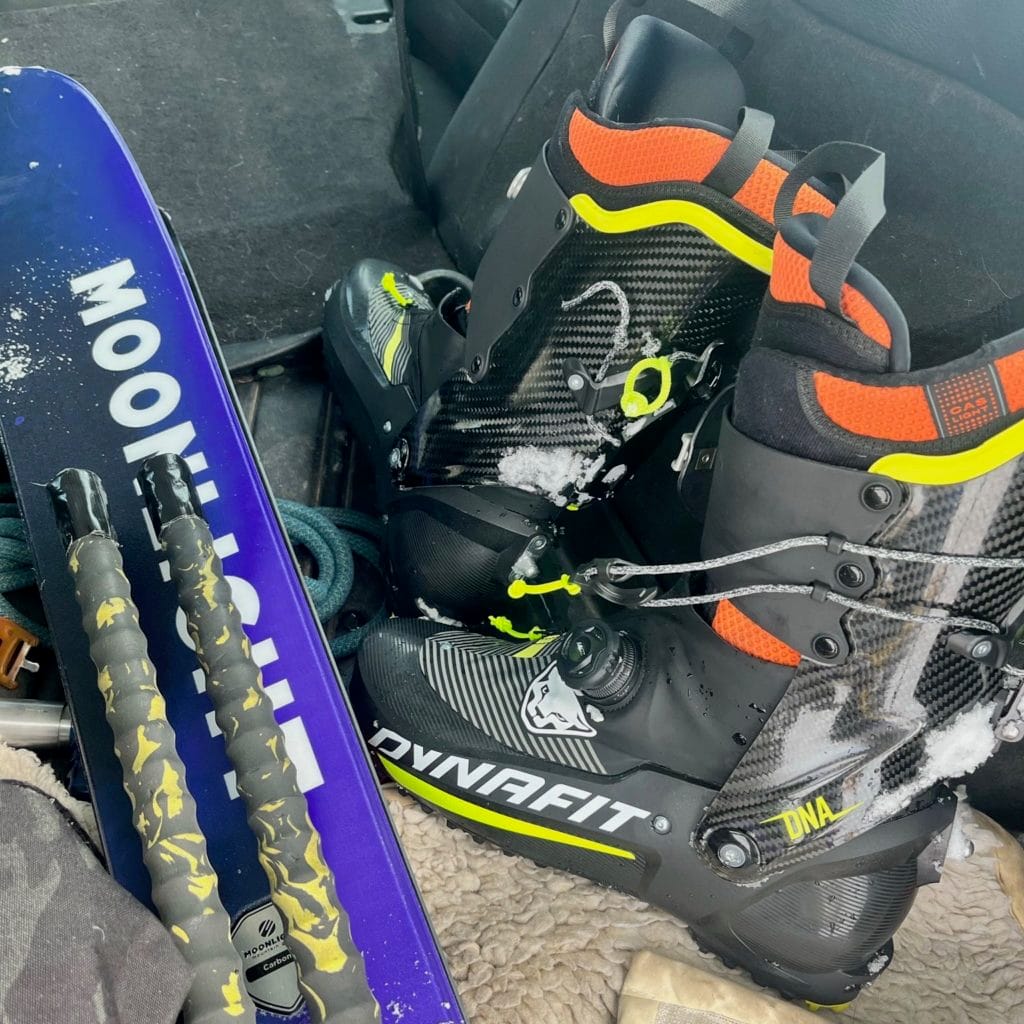

Dynafit DNA Boot Overview
Consistent with some of my other outside the box ski gear ideas, my first day skiing the Dynafit DNA was a ~15” powder day, paired with 120mm Moonlight Cruiser skis. I had a blast.
New in 2022, the Dynafit DNA is something between a replacement for the now discontinued PDG 2 and a bridge to the pricey DNA by Pierre Gignoux model. As a non-racer, the PDG never seemed like a viable option for driving slightly bigger skis, and the Gignoux boots, while extremely sexy, always felt like a bit much, both in price and carbon content. Come fall 2022, as I mourned the demise of my beloved set of Scarpa Alien RS, seeing the new DNA boot gave me a sliver of hope.
My hopes were tempered by a bit of concern about fit–Dynafit boots have been all over the map for a little while now, from cavernous models like the TLT7 or Hoji Pro, to low volume options like the Hoji Free; I wasn’t sure what to expect. More on fit later, but the DNA is pretty darn low volume.
Over the past few seasons, Dynafit has significantly improved its boot game, from these new DNA and the similar Mezzalama model to the TLTX, Radical Pro, and Tigard. Dynafit offers competitive boots (with toe welts) ranging from 800g race boots to 1600g 50/50 boots.
Design Highlights
The DNA is categorized as a pure skimo race boot and would likely perform admirably in such a role. For better or worse, I don’t find it particularly interesting, assessing how a boot performs survival skiing as fast as possible on 65mm skis in bad snow (although that can be very exciting in the moment!). My vision for the DNA was to class things up a little and see if it could compete in the ever-busier 1 kg category. Though I have really enjoyed other 1 kg boots, especially the Technica Zero G Peak, lately, I often missed the slick, single throw transition of my beloved Alien RS. Also, the Tecnica is light and skis well, but the walking isn’t as friction-free as I would like some days.
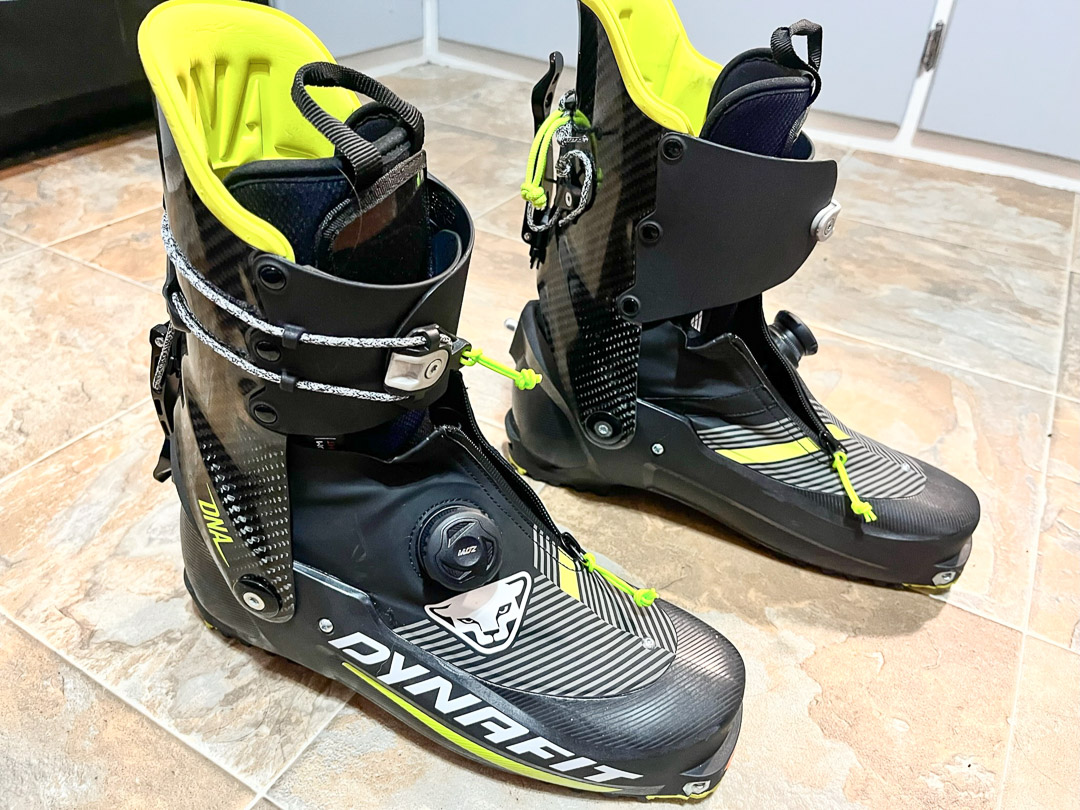
The DNA has some race features that set it apart from most of the 1 kg boots out there. A full carbon cuff is perhaps the biggest difference. With a full carbon cuff and carbon-loaded Grilamid lower, this puts the DNA in the category of the Scarpa Alien 1.1 and La Sportiva Raceborg II. Often, these boots (especially the Scarpa) are characterized as extremely stiff and harsh, and just generally challenging to ski. Trying on the DNA and Alien 1.1 side by side, the DNA has a notably softer and less harsh feeling—more similar to the Alien RS than the 1.1.
Speaking of the Alien RS, the basic design of the DNA is very similar. It shares a BOA style lower clog closure—although the implementation is a bit different. Dynafit uses a Twistfit branded system, and the cables tighten down a plastic plate over the instep. The upper closure also more or less resembles the Alien RS (and other race boots) with a single throw to lock the upper cuff into ski mode and tighten a Dyneema cord across the shin. The Dynafit cord system is somewhat refined as well, relative to the Alien RS. It uses a plastic sleeve that latches to a metal stud of sorts, which makes the on/off process a bit easier. Adjusting the cord tension felt a bit more cumbersome than the Scarpa system with the cam–although I know some folks had issues with slipping or de-sheathing the cord, I found it simple to set my desired tightness, then tie a slip knot behind the cam to lock things in place. As for the Dynafit system, I’m not quite sure I have figured out yet.
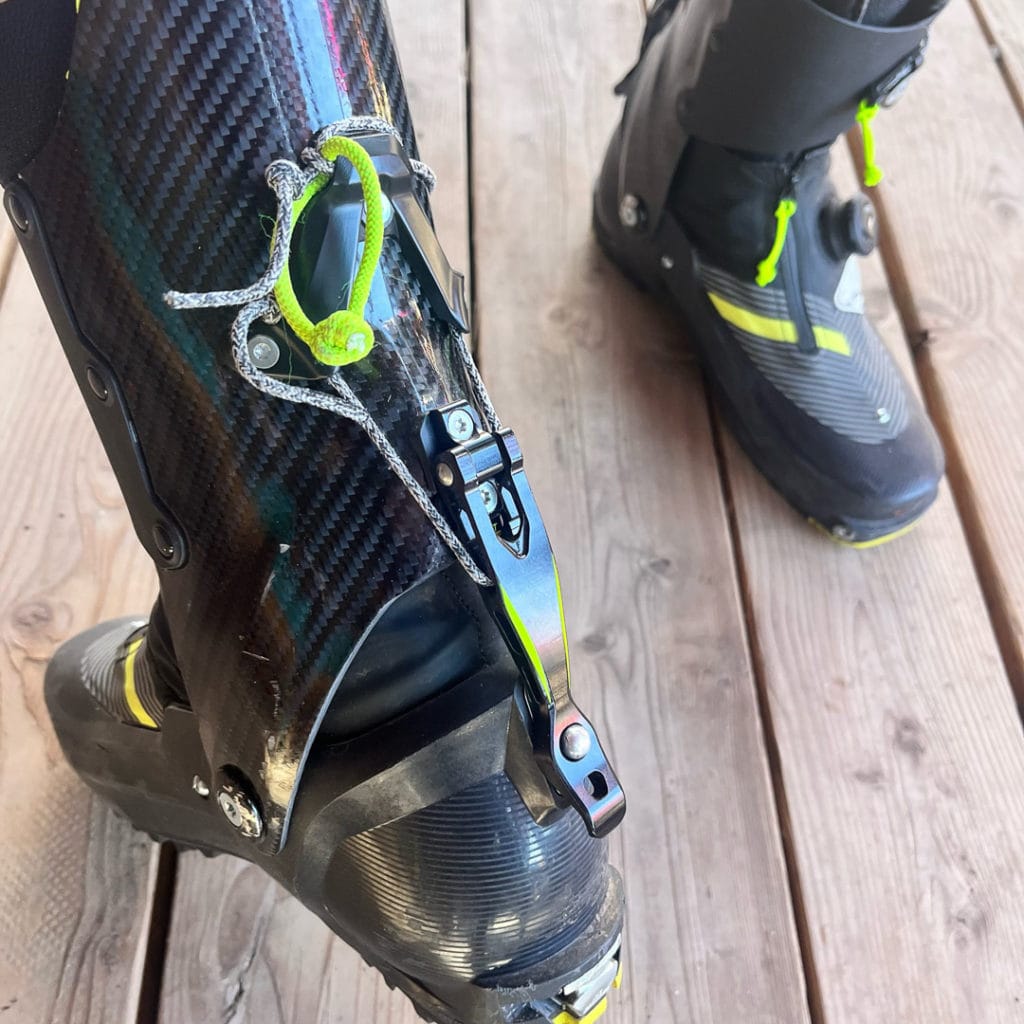
The bayonet style walk/ski mode lever is free floating (no spring loading), and closes onto a round stud. This mechanism feels robust and simple, relative to the svelte nature of the boot. The soles are Pomoca rubber, and non-norm certified–tech bindings only. The open instep of the lower clog is covered by a zippered gaiter that I wish went a little higher for my powder skiing exploits. While there were early reports of zipper failure on these boots and their cousin the Mezzalama, I mitigated this by only operating the zipper with the Twistfit tightened, to limit the stress on the zip. The forward lean is adjustable between 10 and 13 degrees by flipping the stud on the lower shell.
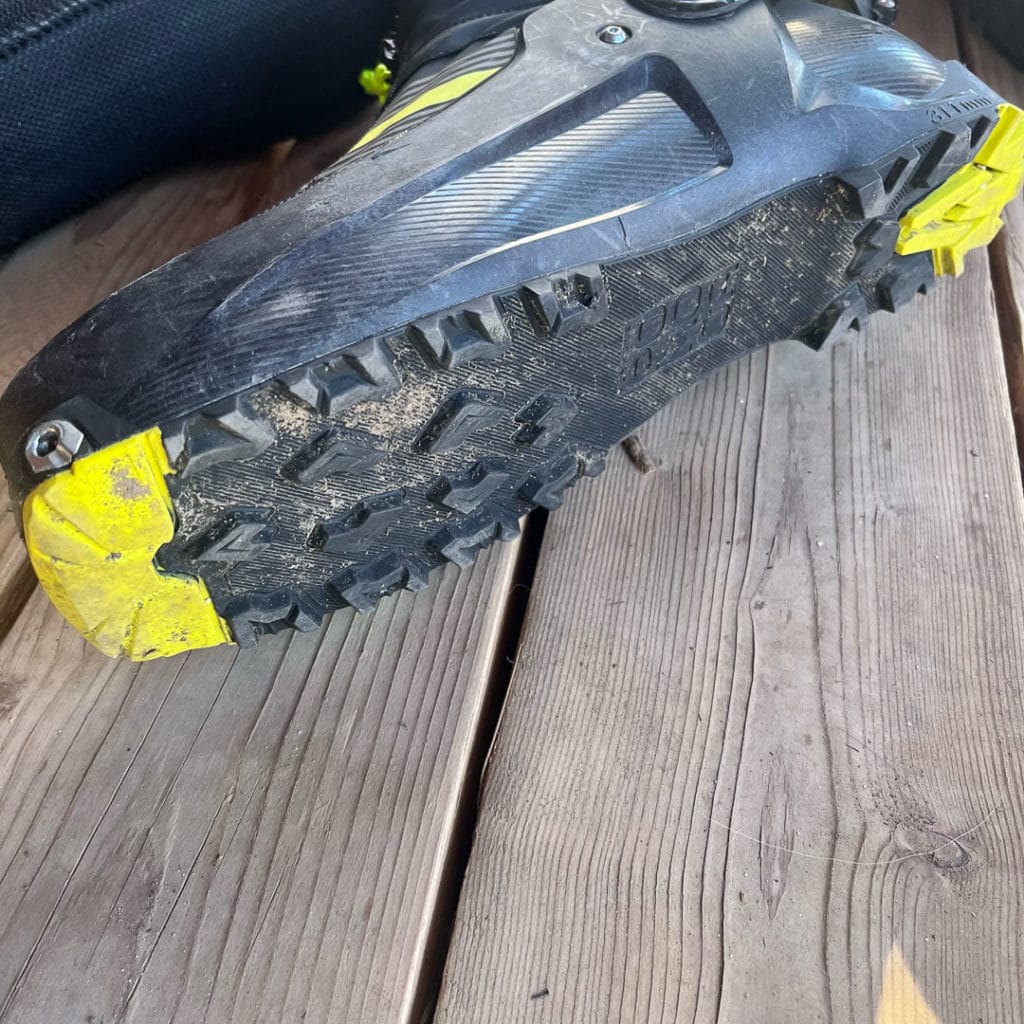
Pomoca outsole, tech bindings only.
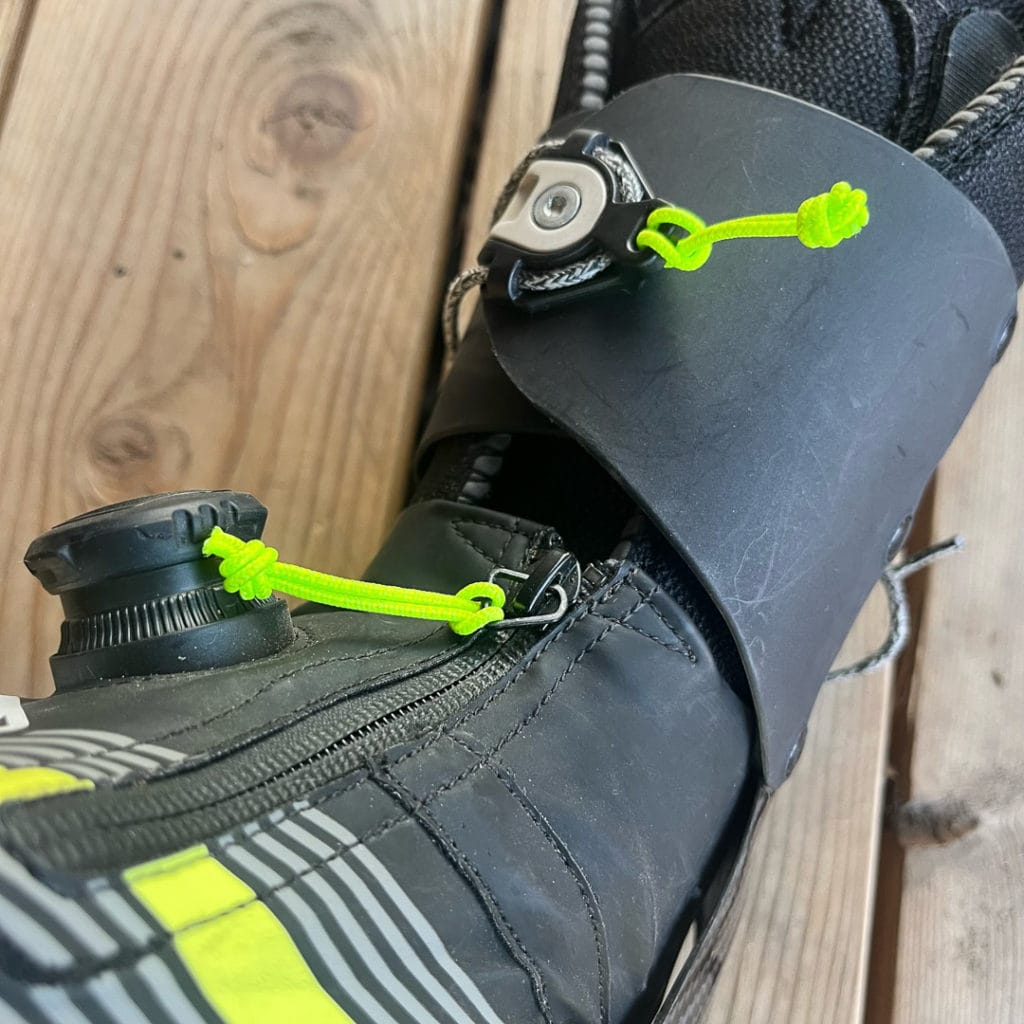

Perhaps the elephant in the room for non-racers is the bikini style liner. My first encounter with a liner like this wasn’t all bad, I used the bikini liners for some on piste tours, as well as a few backcountry laps. Certainly, the flimsy and backless liner is a serious compromise to downhill performance, but holy cow do they walk well—we are talking near zero friction over a much wider ROM than my ankle is capable of. I ended up swapping the liners, more on this later.
Fit and Bootfitting
I am the proud owner of feet that are large (EU 46 or so), but also narrow and low volume. I have a medium-low instep, medium arch, and fairly bulbous sixth toes. I often need sixth toe punches and occasionally padding or shimming in the heel cup of new boots to mitigate heel lift. I opted for the size 29.5/30 shell, which, at 311 mm is a touch shorter than my size 30 Alien RS that was 318 mm. Internal length was also a touch shorter on the DNA, but I would likely recommend the same sizing as Scarpa. I wear a 28.5 in Technica Zero G/Peak and others, for reference.
The most notable fit-feature of the DNA is the very low volume forefoot, the toe box and midfoot height is the lowest of any boot I have worn, but the width is decidedly medium (no sixth toe punches needed for me). I struggled a bit with heel hold, as the heel area is a bit higher volume than the rest of the boot. I often felt that the Twistfit tightening in the forefoot could have gone a hair higher toward my ankle to assist with heel hold, or I have contemplated some sort of a modification for an instep buckle to alleviate this issue—perhaps I’ll explore this in the future. For the time being, a liner swap and some padding is doing an adequate job.
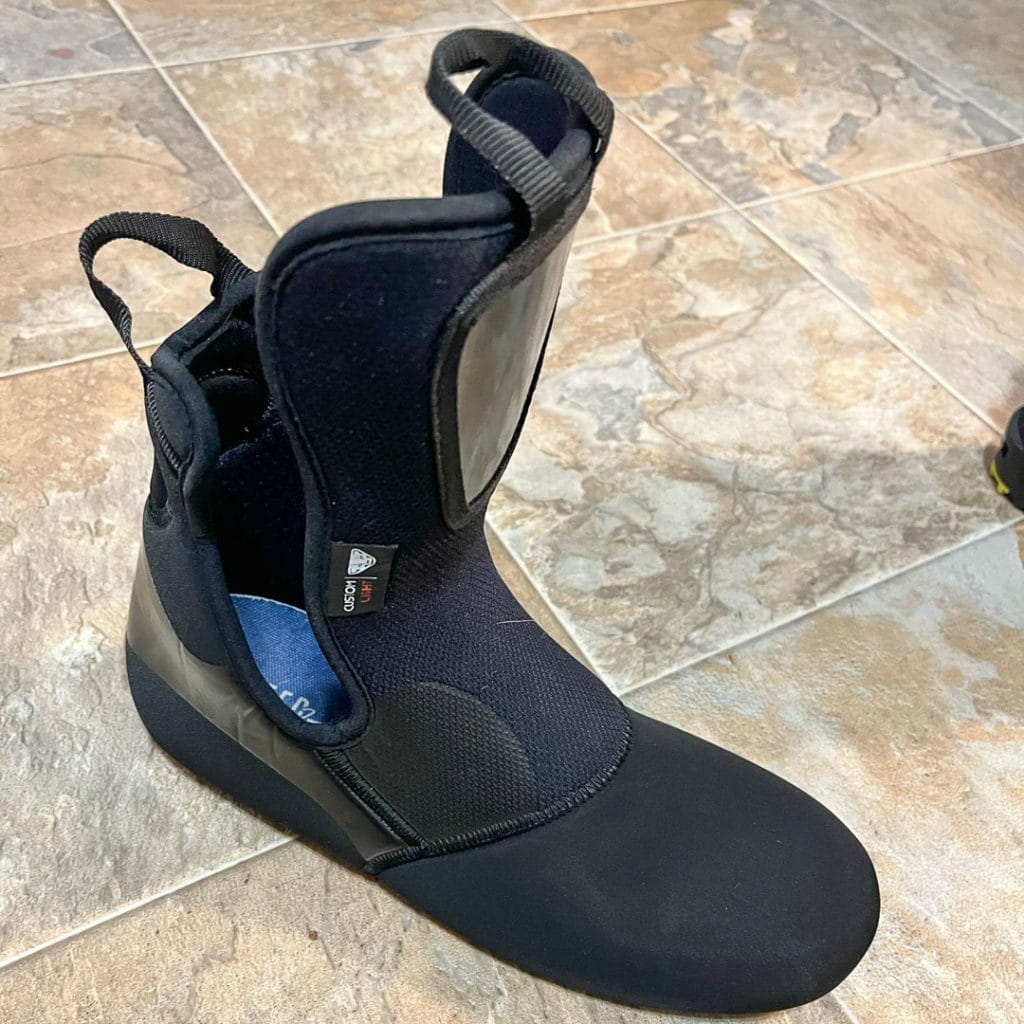
As far as boot work goes, the stock liner took some shape from heat molding, but there isn’t much material to work with. The carbon cuff is not readily modifiable, but the lower should take small amounts of punching. There are some reinforced areas molded into the lower shell (similar to the Lambda Frame on the Alien RS) that would likely be challenging to work around for some punches in the midfoot area.

Field Testing
I skied a bit with the stock liner, but mostly tested with an Intuition Tour Mod, which is essentially an Intuition foam, super simple and thin race liner. I also tried the stock Zero G Peak Liner for a few days—mostly to see if I liked the full liner before purchasing the Intuition. I added a super thin Kneed 2 Fit insole to each of the liners as well.
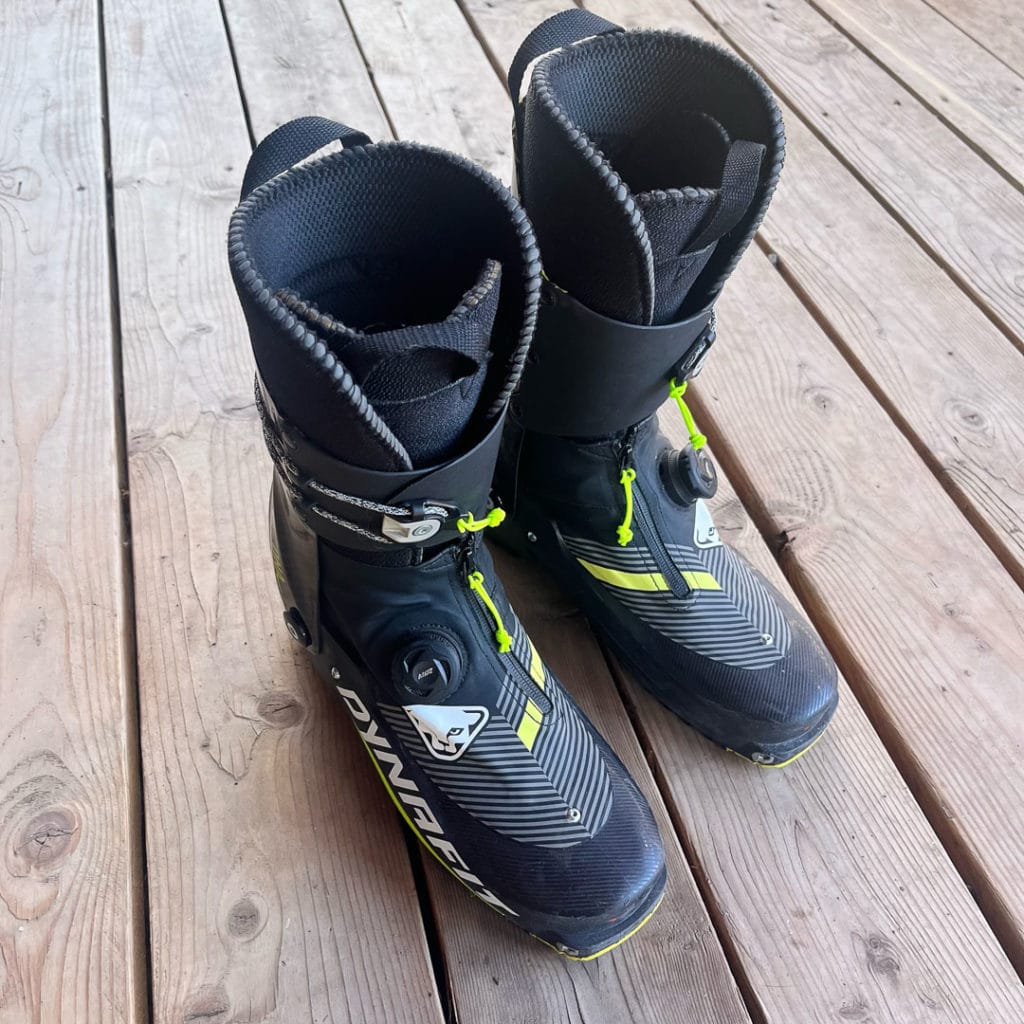
The walk mode, like I mentioned, was exceptional. With the bikini liner it was truly frictionless—and the Intuition broke in to be only slightly inhabiting of the previous perfection. This is the norm with race boots, but it did not disappoint. As a frequent enjoyer of walk mode skiing, the DNA made this activity extra spicy (sketchy?).
Ski performance is the real question mark here. I skied with the whole range of skis from 85mm ZAG Adret 85’s, all the way up to 4FRNT Hojis and Moonlight Cruisers. The biggest caveat here is choosing the right conditions. Big skis and poor snow quality paired with the DNA is a recipe for failure. However, big skis, deep pow and DNA’s were absolutely delightful. The Moonlight Cruiser, specifically, requires consistent forward pressure that isn’t always friendly to the lightest boots. The DNA was able to power the Cruisers better than expected, given the absurdity of the combination. Again, snow quality is key here.
Side by side, not skiing, the DNA and Alien RS flex felt similar but the extra bit of harshness of the full carbon DNA cuff was present and noticeable. In the field, though, I was able to ski very similarly between the two boots. That’s to say, somewhat more centered and upright than I might with a four buckle boot, but with confidence that I had a supportive cuff to flex into to make precise or more powerful turns as needed. To me, this is a great success for the DNA.
Skiing more appropriate skis such as the ZAG Adret 85, the DNA felt like a suitable match and I was generally psyched on the skiing performance. I felt I was able to push this setup at higher speeds and in worse snow than expected. One thing I had to adjust after some firm skiing was the cuff padding. Essentially, with the glued in calf padding, in addition to the full Intuition liner, the forward lean felt a bit excessive, given the more centered weight distribution demanded by such boots. During a long day that ended with a ~10 mile, low angle descent, I started to feel like I was doing a wall sit or something anytime the boots were in ski mode. A few painful quad-cramping episodes later, I got home and trimmed/peeled the foam out of the back of the boot. Issue solved.
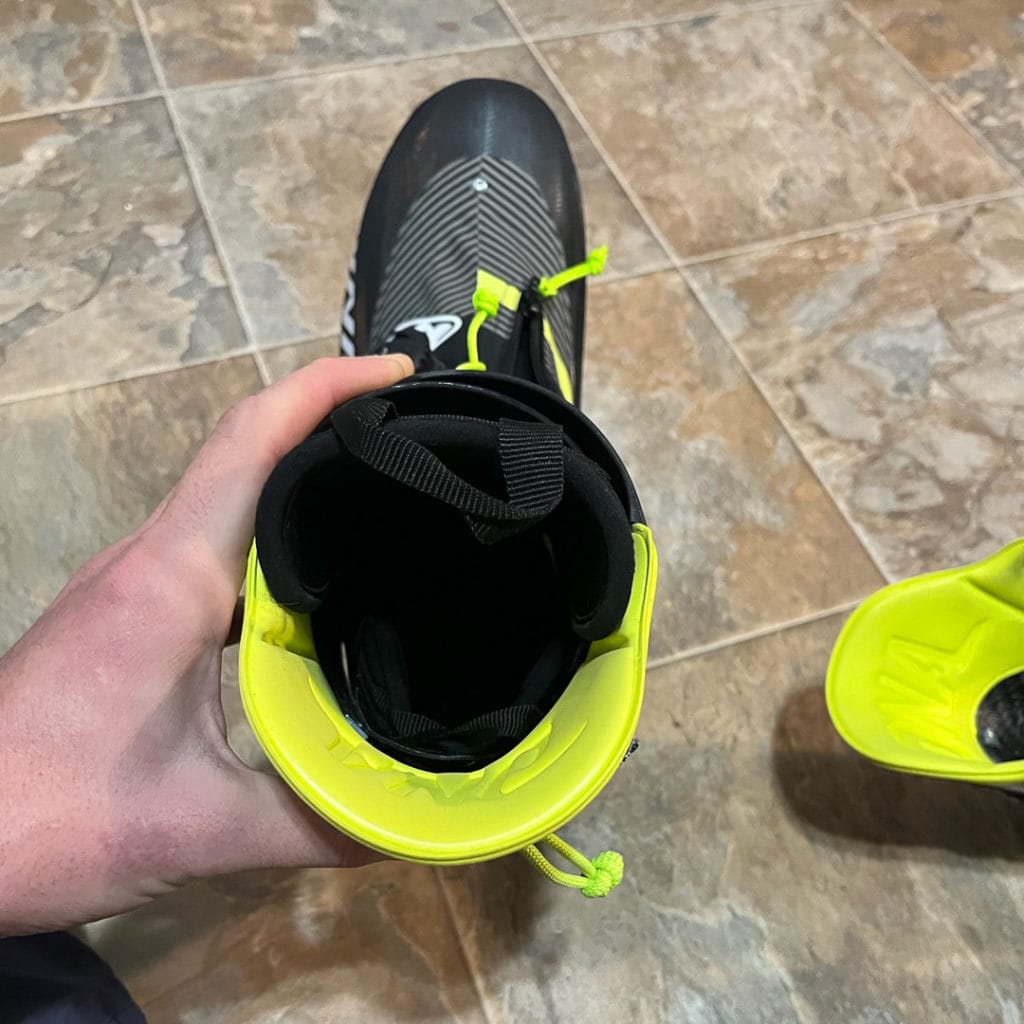
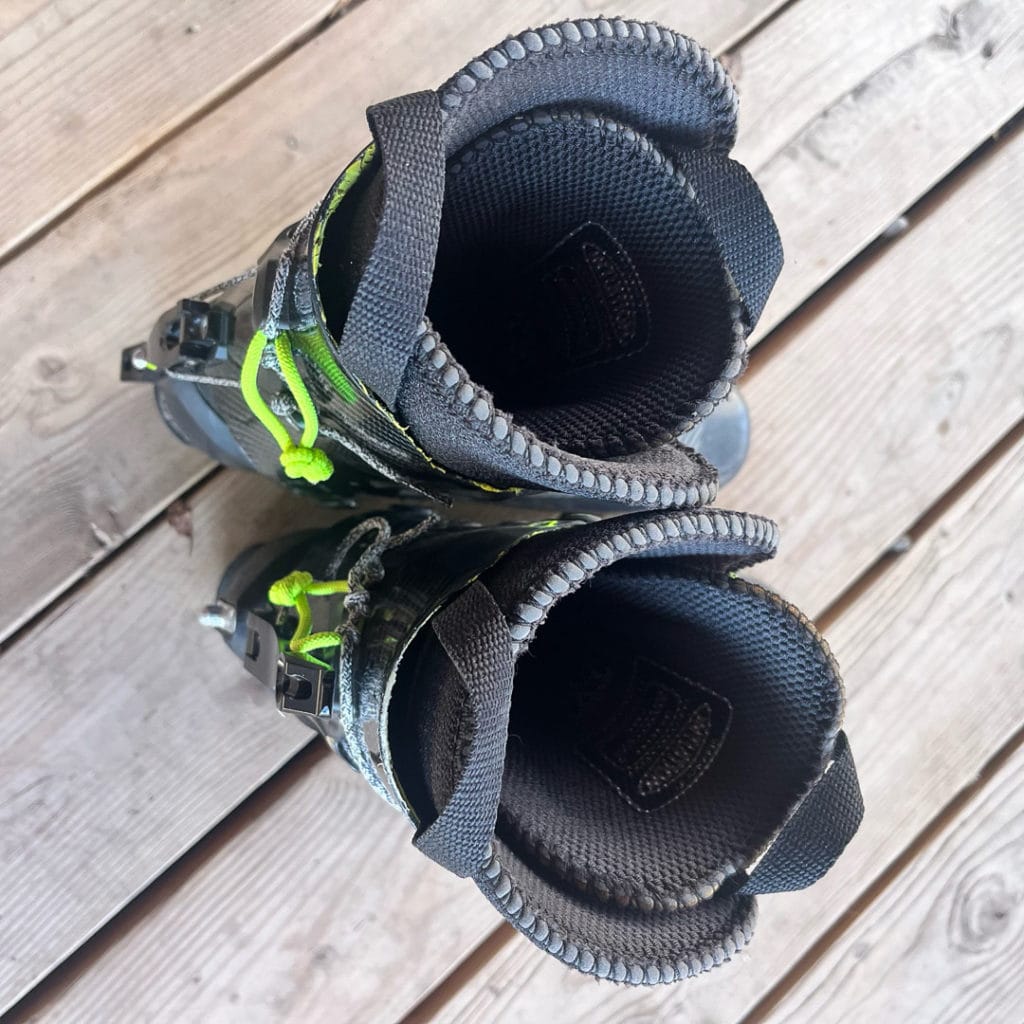
I put a few dings in the carbon cuff, which feels more concerning than dings in a plastic cuff, but didn’t cause any issues so far. So far, the gaiter is well attached, and likely the low cut will prevent it from tearing away as seems to be an issue in many similar boots with high gaiters. Like I stated earlier, no zipper issues yet, though I have been babying it. Same goes for the cord closure and twistfit—I try to be careful with these mechanisms, and haven’t had any issues. Similarly, I skied a single pair of Alien RS for two seasons, most days, and never broke the cord or BOA.
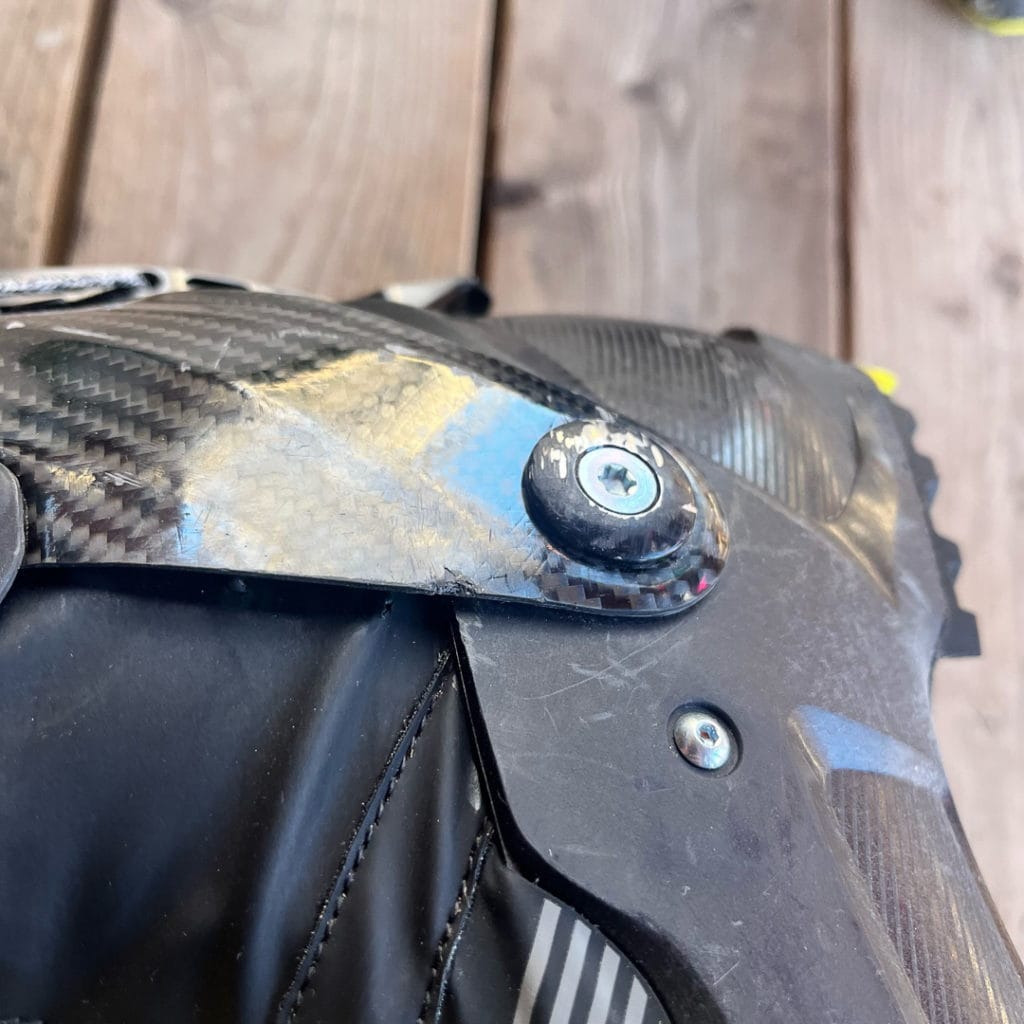
The low gaiter is a bit of a downer for trailbreaking or skiing in deep snow. This is certainly a “me problem” as Dynafit would tell you that’s not exactly what these boots were designed for. Despite no spring mechanism in the walk mode lever, it has a well designed pivot that adds friction to keep the lever from flopping around. This worked great for me, maybe even better than spring loaded levers that sometimes snap into ski mode with an errant tap.
Crampon compatibility was not an issue with anything I tried. They fit painlessly with Blue Ice Harfangs, Petzl Irvis Hybrids, and Camp Nanotech models. They don’t look to be Dynafit Cramp-in compatible, which seems fine… aside from my heel lift issues, the DNA climbed ice and snow very well. Picture a XC skiing skate boot when you are moving along in the DNA in walk mode.
Conclusion
It is important to recognize what you are buying when you get into a boot like the DNA. It would be easy to write a negative review along the lines of “These boots ski like shit compared to my four buckle freeride boots!” Instead, think of it this way—we are taking a boot meant for a single, very specific purpose, skimo racing, and adapting it to various other forms of ski touring. The Alien RS also did this, by design, rather than making some mods and adaptations here. What this gets you is absolutely unrivaled uphill enjoyment and efficiency, with compromises on the downhill. The impressive thing here is this: that with the right skis, on the right day, freeride style, complete with fast sweeping turns and small airs is both possible and extremely fun. In my world, I am always seeking balance between efficiency to ski as much as possible and making skiing as enjoyable as possible. The DNA fills an interesting and efficient niche in this spectrum.
DNA Boot Specs
Weight Size 29.5: 953g (Including Intuition liner, footbed and calf foam removed) stock was 998g with footbed. I saved weight?!?!
Construction: Carbon upper cuff, carbon laoded Grilamid Lower
Closer Systems: Twistfit (BOA like) lower closure, dyneema cord upper
Range of Motion: 60 degrees claimed ROM—extremely low friction
Liner: Bikini style, minimalist race liner is stock. I added the Intuition Tour Mod
Forward Lean: Adjustable 10 or 13 degrees.
Price: $999.95

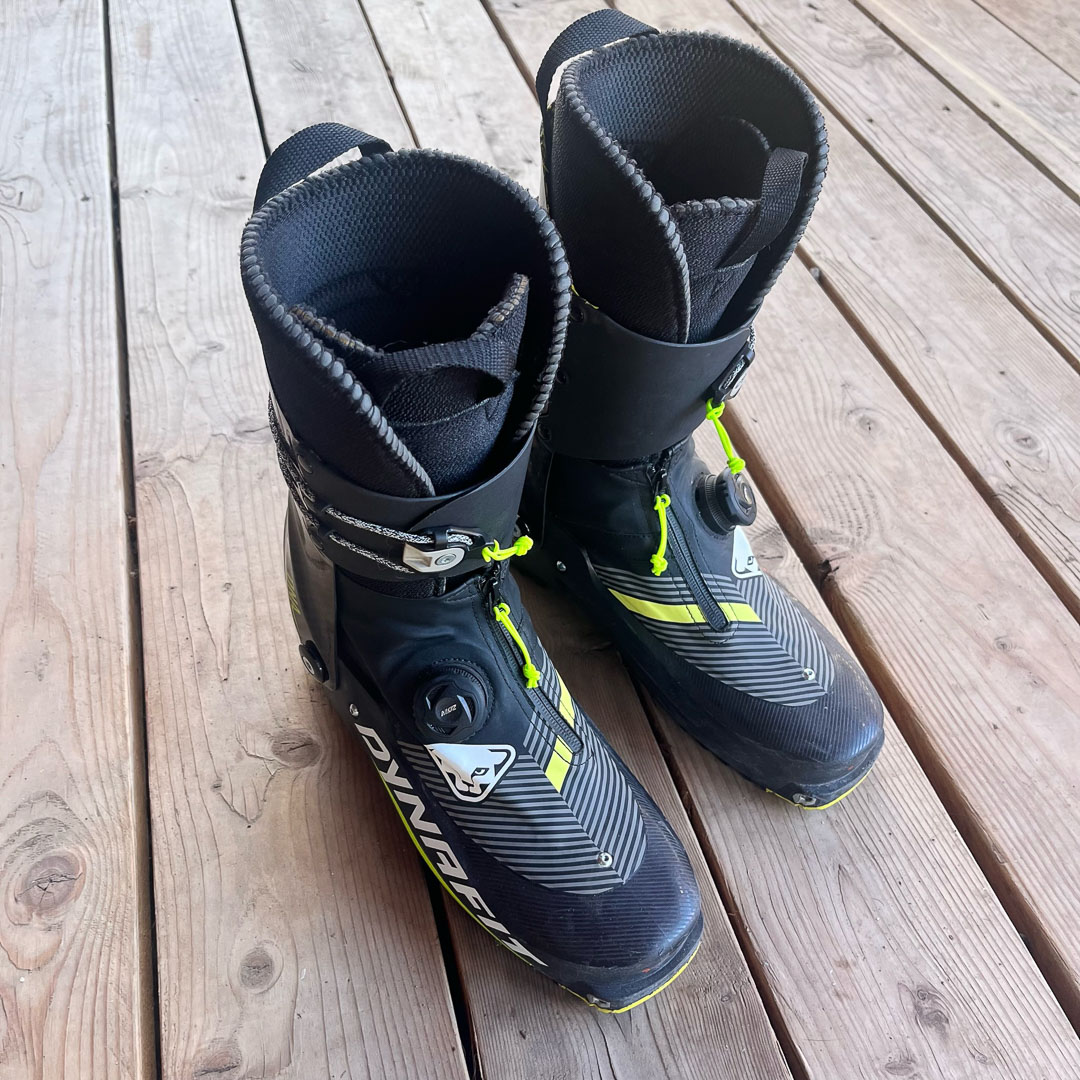


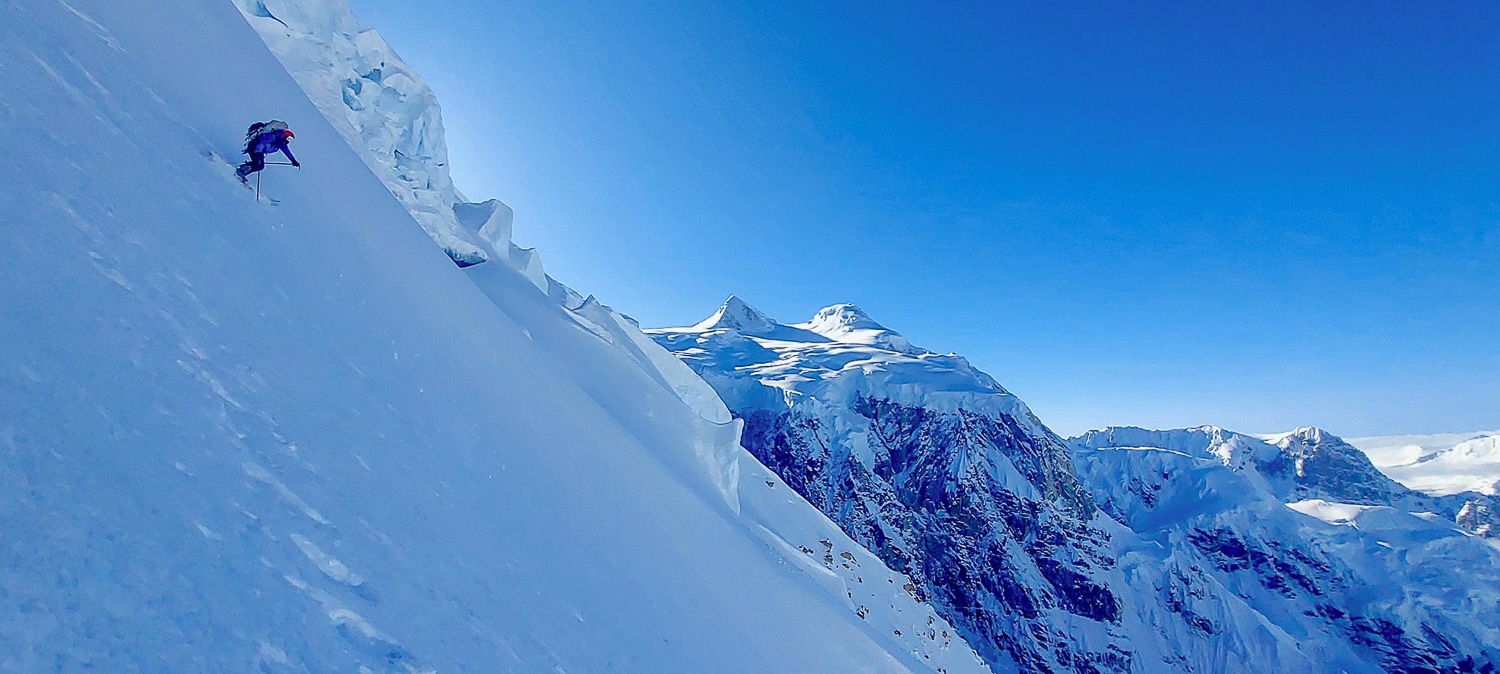
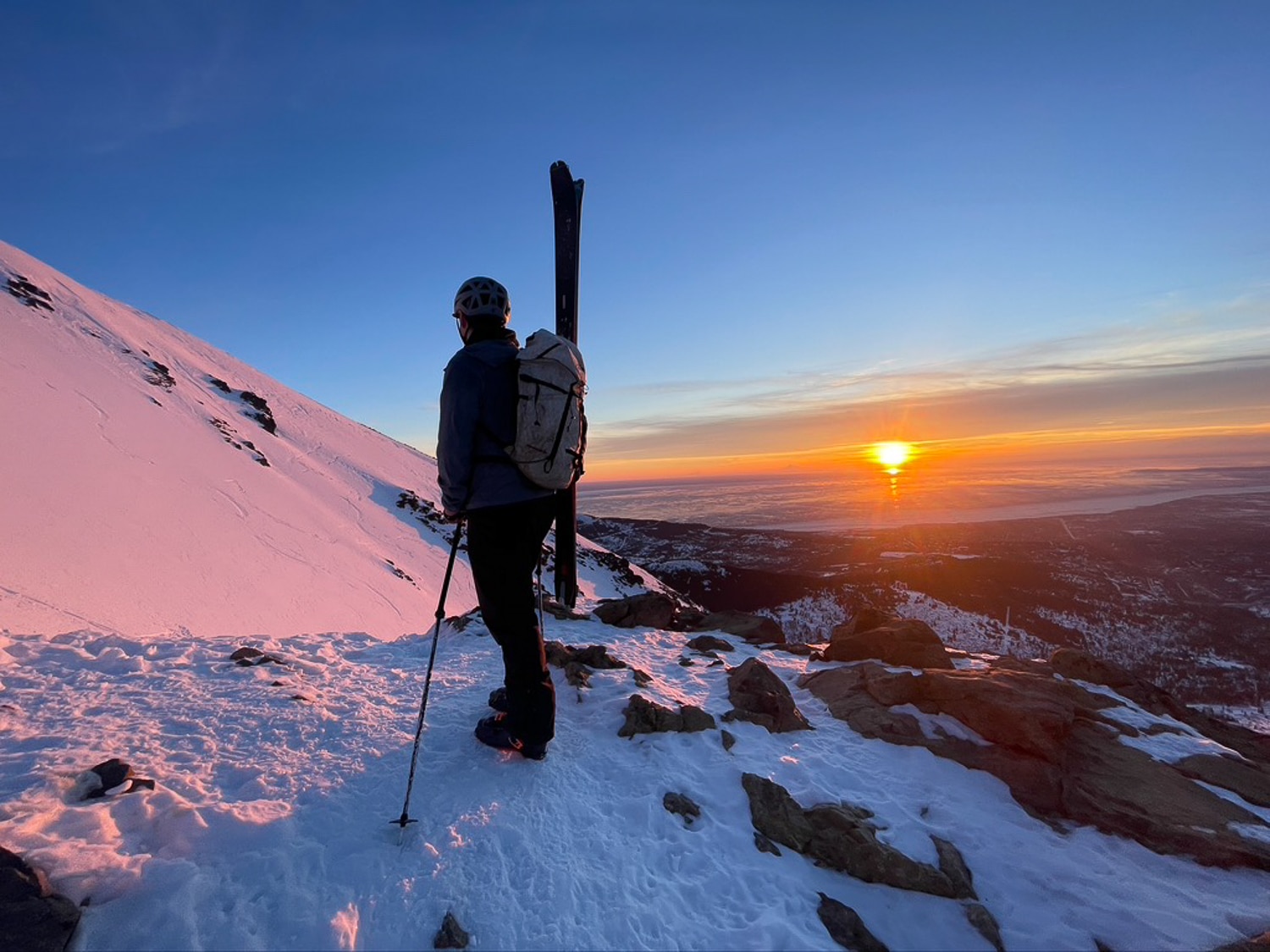
Leave a Reply
You must be logged in to post a comment.